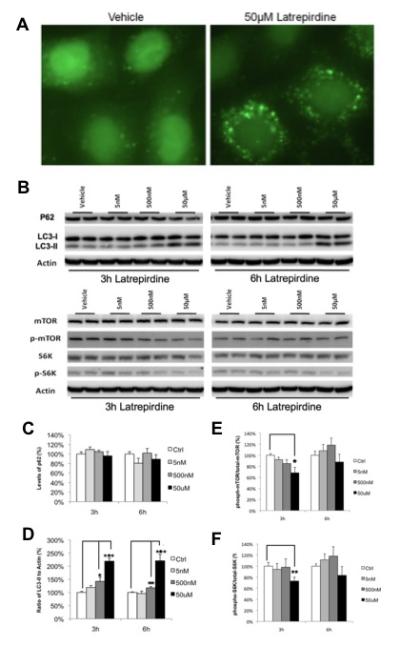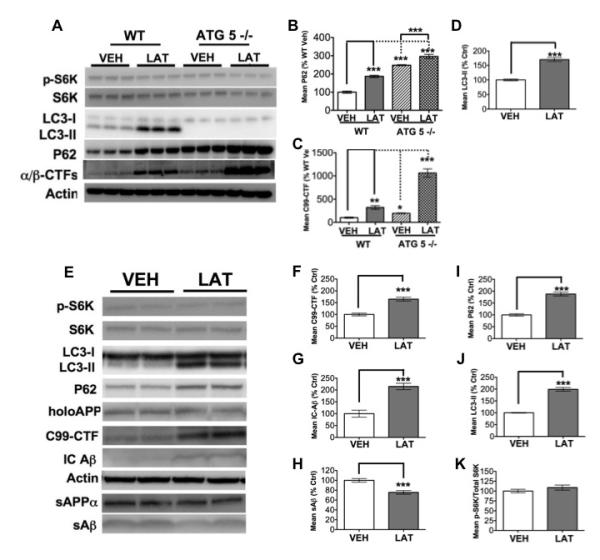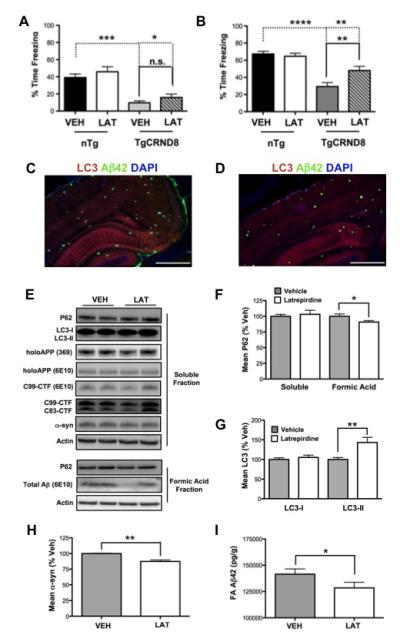
| Size | Price | Stock | Qty |
|---|---|---|---|
| 5mg |
|
||
| 10mg |
|
||
| 25mg |
|
||
| 50mg |
|
||
| 100mg |
|
||
| 250mg |
|
||
| 500mg | |||
| Other Sizes |
Purity: ≥98%
Latrepirdine HCl (Dimebon; Dimebolin; Dimeboline; Preparation 84), the hydrochloride salt of Latrepirdine, is an orally bioactive, neuroactive and non-selective antihistamine drug with the potential to be used for Alzheimer's disease and Huntington's disease. In addition, it is an antagonist of several other targets, such as GluR and 5-HT receptors, which are used in antihistamine medications. It has been demonstrated that latrepirdine prevents the death of brain cells in animal models of Huntington's and Alzheimer's diseases. According to research, it might also improve cognition in healthy people. Russia and other nations have employed latrepirdine in clinical settings; however, a Phase III clinical trial for the treatment of Alzheimer's disease was unable to demonstrate any benefit.
| Targets |
Histaminergic receptor; Serotonergic receptor; Amyloid-β (Aβ); α-adrenergic receptor
|
||
|---|---|---|---|
| ln Vitro |
|
||
| ln Vivo |
|
||
| Cell Assay |
The following are kept in "growth medium" (high glucose Dulbecco's modified Eagle's medium supplemented with 10% FBS and 100 units/mL Penicillin/Streptomycin) at 37°C, 5% CO2: N2a cells, stable human cervical carcinoma (HeLa) cells expressing EGFP-LC3, and mouse embryonic fibroblasts (MEFs) derived from wildtype mice or ATG5-/- mice. N2a cells that have been transfected with APPK670N and M671L are kept in growth medium that has been enhanced with 0.2 mg/mL G418. After a 1-inch wash with ice-cold PBS (pH 7.4), the cells are cultured in growth medium or latrepirdine (5 nM, 500 nM, or 50 μM). After treatment for three, six, or twenty-four hours, cells are collected and centrifuged at 14,000 RPM for fifteen minutes at 4°C in lysis buffer (50 mM Tris-HCl, 150 mM NaCl, 1 mM Pepstatin, 1 mM PMSF, 1% Triton X-100, EDTA-free mini-complete protease inhibitor cocktail tablet). In time-course studies, cells are rinsed twice with ice-cold PBS (pH 7.4) and then cultured in serum-free DMEM supplemented with 50 μg/mL CHX or 50 μg/mL Cycloheximide (CHX)+50 μg/mL Chloroquine (CQ) for the specified duration. Samples for baseline (T0) are taken right before treatment[1].
|
||
| Animal Protocol |
|
||
| References |
| Molecular Formula |
C21H27CL2N3
|
|
|---|---|---|
| Molecular Weight |
392.37
|
|
| Exact Mass |
391.158
|
|
| Elemental Analysis |
C, 64.28; H, 6.94; Cl, 18.07; N, 10.71
|
|
| CAS # |
97657-92-6
|
|
| Related CAS # |
3613-73-8; 97657-92-6 (HCl)
|
|
| PubChem CID |
23729232
|
|
| Appearance |
White to khaki solid powder
|
|
| LogP |
5.425
|
|
| Hydrogen Bond Donor Count |
2
|
|
| Hydrogen Bond Acceptor Count |
2
|
|
| Rotatable Bond Count |
3
|
|
| Heavy Atom Count |
26
|
|
| Complexity |
425
|
|
| Defined Atom Stereocenter Count |
0
|
|
| SMILES |
Cl.N1C(C)=CC=C(CCN2C3CCN(CC=3C3C2=CC=C(C)C=3)C)C=1
|
|
| InChi Key |
GTWLIQOLGOZTLF-UHFFFAOYSA-N
|
|
| InChi Code |
InChI=1S/C21H25N3.2ClH/c1-15-4-7-20-18(12-15)19-14-23(3)10-9-21(19)24(20)11-8-17-6-5-16(2)22-13-17;;/h4-7,12-13H,8-11,14H2,1-3H3;2*1H
|
|
| Chemical Name |
2,8-dimethyl-5-[2-(6-methylpyridin-3-yl)ethyl]-3,4-dihydro-1H-pyrido[4,3-b]indole;dihydrochloride
|
|
| Synonyms |
|
|
| HS Tariff Code |
2934.99.9001
|
|
| Storage |
Powder -20°C 3 years 4°C 2 years In solvent -80°C 6 months -20°C 1 month Note: Please store this product in a sealed and protected environment, avoid exposure to moisture. |
|
| Shipping Condition |
Room temperature (This product is stable at ambient temperature for a few days during ordinary shipping and time spent in Customs)
|
| Solubility (In Vitro) |
|
|||
|---|---|---|---|---|
| Solubility (In Vivo) |
Solubility in Formulation 1: ≥ 0.5 mg/mL (1.27 mM) (saturation unknown) in 10% DMSO + 40% PEG300 + 5% Tween80 + 45% Saline (add these co-solvents sequentially from left to right, and one by one), clear solution.
For example, if 1 mL of working solution is to be prepared, you can add 100 μL of 5.0 mg/mL clear DMSO stock solution to 400 μL PEG300 and mix evenly; then add 50 μL Tween-80 to the above solution and mix evenly; then add 450 μL normal saline to adjust the volume to 1 mL. Preparation of saline: Dissolve 0.9 g of sodium chloride in 100 mL ddH₂ O to obtain a clear solution. Solubility in Formulation 2: ≥ 0.5 mg/mL (1.27 mM) (saturation unknown) in 10% DMSO + 90% (20% SBE-β-CD in Saline) (add these co-solvents sequentially from left to right, and one by one), clear solution. For example, if 1 mL of working solution is to be prepared, you can add 100 μL of 5.0 mg/mL clear DMSO stock solution to 900 μL of 20% SBE-β-CD physiological saline solution and mix evenly. Preparation of 20% SBE-β-CD in Saline (4°C,1 week): Dissolve 2 g SBE-β-CD in 10 mL saline to obtain a clear solution. View More
Solubility in Formulation 3: ≥ 0.5 mg/mL (1.27 mM) (saturation unknown) in 10% DMSO + 90% Corn Oil (add these co-solvents sequentially from left to right, and one by one), clear solution. Solubility in Formulation 4: 100 mg/mL (254.86 mM) in PBS (add these co-solvents sequentially from left to right, and one by one), clear solution; with ultrasonication. |
| Preparing Stock Solutions | 1 mg | 5 mg | 10 mg | |
| 1 mM | 2.5486 mL | 12.7431 mL | 25.4861 mL | |
| 5 mM | 0.5097 mL | 2.5486 mL | 5.0972 mL | |
| 10 mM | 0.2549 mL | 1.2743 mL | 2.5486 mL |
*Note: Please select an appropriate solvent for the preparation of stock solution based on your experiment needs. For most products, DMSO can be used for preparing stock solutions (e.g. 5 mM, 10 mM, or 20 mM concentration); some products with high aqueous solubility may be dissolved in water directly. Solubility information is available at the above Solubility Data section. Once the stock solution is prepared, aliquot it to routine usage volumes and store at -20°C or -80°C. Avoid repeated freeze and thaw cycles.
Calculation results
Working concentration: mg/mL;
Method for preparing DMSO stock solution: mg drug pre-dissolved in μL DMSO (stock solution concentration mg/mL). Please contact us first if the concentration exceeds the DMSO solubility of the batch of drug.
Method for preparing in vivo formulation::Take μL DMSO stock solution, next add μL PEG300, mix and clarify, next addμL Tween 80, mix and clarify, next add μL ddH2O,mix and clarify.
(1) Please be sure that the solution is clear before the addition of next solvent. Dissolution methods like vortex, ultrasound or warming and heat may be used to aid dissolving.
(2) Be sure to add the solvent(s) in order.
| NCT Number | Recruitment | interventions | Conditions | Sponsor/Collaborators | Start Date | Phases |
| NCT00788047 | Completed | Drug: Dextromethorphan Drug: Dimebon + Dextromethorphan |
Huntington Disease Alzheimer Disease |
Pfizer | November 2008 | Phase 1 |
 |
|---|
 |
 |